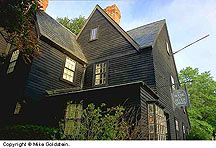
Boom. A heavy thud, like distant cannon fire, wakes us from a sound sleep just after dawn. The whole house shakes. Where am I?
The bed vibrates slightly in a way I remember experiencing during a slight earthquake in Bermuda many years ago. But this is no earthquake. We’re staying at the Spray Cliff Inn just outside Marblehead, Massachusetts, a marvelous bed-and-breakfast that is aptly named. The tide is high, and the sound is the ocean beating against a forty-foot seawall that lies directly below our window.
High tide makes a great alarm clock. The sun will soon be over the horizon. What am I doing in bed?
I hurry to a point of land just seaward of the Inn that allows me to look back toward the shore. My tripod is set up and ready as the best of the morning light makes the Inn and the waterline glow, bright enough that a fast shutter speed will stop the high surf in its tracks. No need for a polarizer here, as the sun is behind me, but an 81 B warming filter helps.
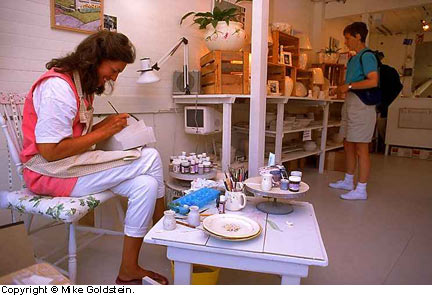
In Rockport, artisan galleries abound. Half of the fun in browsing them is watching the artists busily creating new works for future customers. Here, Junie Tew works on a new creation in the “Too Fortunate Pottery”, on Dock Square. Junie claims her last name comes from Greater and Lesser Tew, small towns in England’s Cotswolds region.
Available incandescent lighting was augmented by bouncing flash light from the low, white ceiling in this room. A flash meter was used to measure the amount of bounce flash. Note the “vee” of the table in the foreground of the composition, a compositional ploy I like to use, to create ‘leading lines
Marblehead, the sailing center of Massachusetts, was already thriving when Sir Edward Cornwallis founded Halifax, Nova Scotia, in 1749. The Old Town boasts many buildings which predate that event by decades. The streets are narrow, and parking is almost impossible. Stumbling on the Old Town House (1727) is an historic occasion for us, for it marks what might be the only public parking lot in the Old Port. We leave our van for the day in order to enjoy hours of walking up twisting alleys and down tiny lanes.
The harbor area, alone, is worth the trip for its photographic possibilities. A sailing school is readying its dinghies as we arrive, and I manage a few grab shots. A quick walk up a hill yields a “bird’s eye view” of the harbor with the many yachts moored therein. You never know when you might stumble across an “old salt” carving a boat or fixing a net, a wonderful subject for a portrait. If it’s a sunny day, be sure your outboard flash is ready, and you’re familiar with the technique of providing “fill light”. The shadows under the “old salt’s” hat will be much darker on your film. Set the fill flash for one f-stop less than the ambient light exposure, and you’re in business.
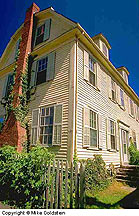
Our introduction to the coast of Massachusetts on a sunny summer day is to drive down King Street hill into Rockport. The blue waters of Pigeon Cove, spread out before us, compliment the bright colors of the umbrellas that decorate Front Beach. Sailboats glide back and forth, children splash in the shallows, and ice cream drips from a hundred sticky hands. The warm breeze is redolent of seaweed and salt.
Having been burned with auto-exposure in a beach environment, I check the exposure by measuring the front lighting from the palm of my hand and mentally opening up one f-stop. If the sun is side-lighting my subject, I’ll open up another stop, and a third stop if my subject is backlit. This technique, infallible for many years, came from one of John Shaw’s excellent books.

A hopeful fisherman casts his line into the morning tide, just down the coast from the town of Marblehead. Under stormy conditions, the surf that beats at the seawall can go as high as the roof lines of these large houses. This lighting can only be obtain just after dawn, when the sun has just cleared the horizon. A blue-yellow polarizer used here will really pop the blues of the sky, and the sea.
It doesn’t take us long to discover Bearskin Neck. A long peninsula that stretches off Dock Square, it’s lined with art galleries, pottery shops, wharves, and boats, and a multitude of seafood restaurants. It’s an artist’s paradise, a browser’s dream, and a gourmet’s seventh heaven. However, it’s bone dry, and that’s not a reference to the humidity level.
A fishing town on the Atlantic coast, dry? Who ever heard of such a thing?

“The Salem Inn”, in the “Bewitching City” of Salem, Mass., offers canopy beds and elegant rooms in which to pamper yourself, after a day of exploring Pilgrim history. Available light was augmented with some flash, bounced from the ceiling, and balanced against the window light, and the lamp, and a 17mm rectilinear lens was used to fit it all in. Shooting with the ‘vee’ of the bed in the foreground provided some leading lines into the composition.
A painting at the entrance of the Hannah Jumper Restaurant, on Tuna Wharf, reveals all. In July of 1856, a formidable lady named Hannah Jumper led two hundred like-minded women in a coordinated attack on the town’s rum supply. Singing the songs of the fledgling Temperance Union, they destroyed every keg, barrel, and bottle of rum they could find. Rockport has remained a dry town to this day.
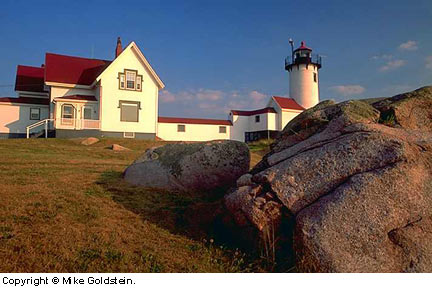
The Eastern Point Light, near Gloucester, is an active Coast Guard post, and the light is still maintained. The most interesting time to visit is just at sundown on a high tide, when the surf pounds the adjacent breakwater. A 24mm lens was used here, with the foreground rock placed prominently in the foreground to draw the eye. The rock breaks the horizon, which makes for a more dynamic composition.
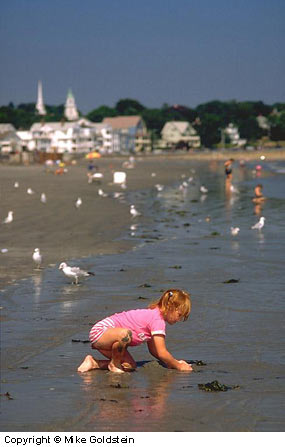
Lynn Beach is one of the best for children to safely enjoy, along the Boston Shore. It has a very gently shelving shore, and little in the way of strong currents. A major road runs right alongside, making it easily accessible. Restaurants are close by, with B & B accommodations just steps away. A strong color accent in the foreground, with buildings breaking the high horizon, are what make this a good composition. Care was taken not to eliminate the reflections in the water, with the polarizing filter that was in use. Care was taken to avoid the usual under-exposure problems encounter by using auto-exposure in high-contrast situations.
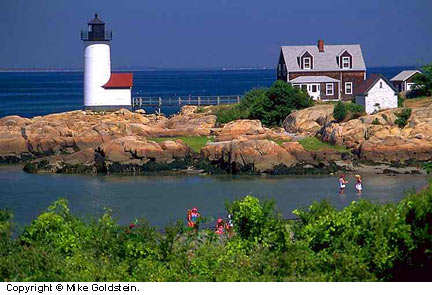
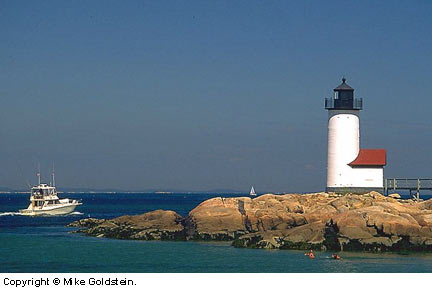
The Annisquam Light is one of many lighthouses along the Boston Shore, most easily reached by car, and a short walk up a hill for this viewpoint. These sentinels of the rocky coast have saved countless mariners’ lives over the years, and all boast an interesting history. Be sure you break the horizon with the light and the buildings, to obtain a dynamic composition. Use of a polarizer here will yield a dark blue sky, behind the white light. Bring a fishing boat in your camera bag, to ‘salt’ the composition, and make it more interesting.
However, seafaring tradition dies hard. As soon as the sailing schooner Appledore III clears Rockport Harbor, the bar opens. For the next two hours, you can sip your favorite tipple while passing lighthouses and islands. Do your photography before you swill grog, however, as those dials and knobs become quite confusing after you “lower the level.” On a sailboat, the only lens you’ll find useful is a wide-angle. Looking upwards into the rigging will yield many delightful compositions.
We spend an afternoon aboard the Super Daunty VII, a large motor vessel operated by the Cape Ann Whale Watch, out of Gloucester. They guarantee whale sightings and provide a marine biologist to explain cetacean habits and identify different species. This is a fabulous experience. Huge, black, rubbery creatures rise from the depths, hissing and blowing fishy vapors. Allison and I enjoy a fascinating afternoon, watching these leviathans of the deep. Humpback whales dominate the day’s activity, supplying constant sightings for the two hours the boat spends on the feeding grounds.
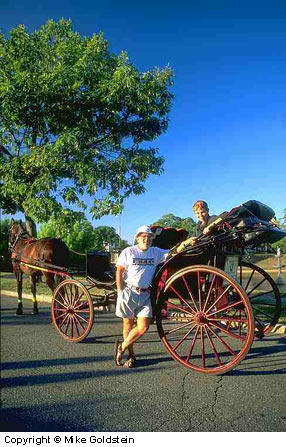
Nothing is quite so elegant as a carriage tour, in the late afternoon, of Newburyport’s shady thoroughfares. Sitting up behind a well-groomed horse and a driver in top hat, it is easy to imagine yourself as New England gentry, riding the perimeter of your grand plantation. Offer your driver some photographic prints, and he’ll quite likely stop for poses, and suggest the best locations for setups.
Capturing whales is tricky photography. First, you have to diplomatically push all the tourists aside (watch out for the vicious three-year-olds!), so you can get a clear shot. Then, you can bet the exposure will change constantly, as the sun peeks in and out of the clouds. Using straight auto-exposure almost guarantees your images will be under or over-exposed, as sky or black whales dominate your composition.
There’s no easy solution but to constantly watch the light and keep a ready finger on the compensation dial. If you’re using a zoom telephoto, you’re going to be busy. I like to keep a second camera, with a wide-angle lens, ready to shoot, as these whales sometimes come close enough to be tickled with a broom handle!
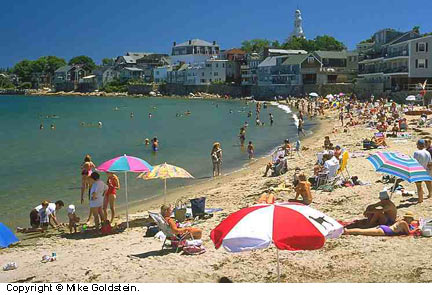
Rockport boasts a beautiful little beach, a popular place for summer visitors. After a swim and some sun, you just stroll along to Bearskin Neck, which is crammed with interesting restaurants and attractive shops. Wide angle lenses, used in beach areas, will provide many intriguing compositions. Repetitive use of round shapes in this image enhance the curve of the beach. Fill flash would be necessary if photographing a subject under one of the umbrellas.
Sunset finds us at the Eastern Point Light, between Gloucester and Rockport. The tide is coming in, and fishermen are dodging the waves that crash over the breakwater. It’s fun to play with filters and lenses as the light changes. I like using my 24mm wide-angle lens for scenics, filling my foreground with a rock or building, delighting in the deep depth of field. Using the Cokin “P series” filter holders reduces the chances of vignetting, with stacked filters.
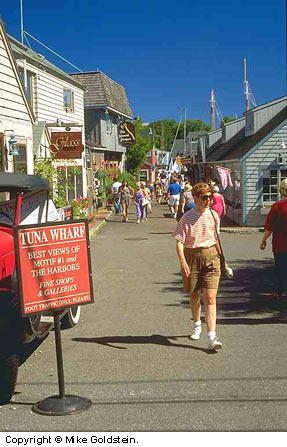
The Tuna Wharf, on Bearskin Neck in Rockport, is the place to shop, enjoy a leisurely lunch, or make reservations for a boat cruise. Like most of the Neck, it’s so popular with tourists that there is no room for motor vehicles, even if they were allowed. This is a people place, so photographing it when there are no tourists about would be a waste of time. There are so many people here that you can pick and choose your composition, and your color accents … you just have to be quick about it, before your image walks off!
Be sure to watch the horizons! Lighthouses can develop a “list to starboard” with time. Don’t let your tripod legs sink into the sand while you’re waiting for the right light. It’s the natural horizon you want to keep level, so resist the temptation to depend on the vertical lines of a building. Perspective is a tricky witch. I use a small plastic bubble level, inserted into the hot shoe of the camera, but I still check the whole image. If you’re doing a dawn shot on a cold morning, keep checking that your tripod legs haven’t slipped with the changing temperature.
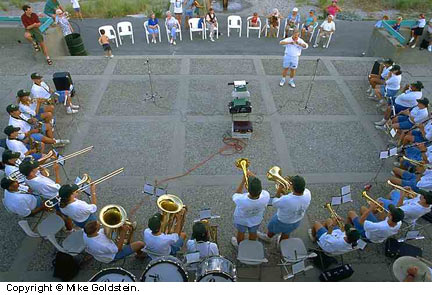
The “Metropolitan All District All Star Band” entertains the strollers on Lynn Beach, in the late afternoon. Made up of high school students from across the Boston area, the band assembles each summer to play in the communities along the Boston Shore. I had to climb up on top of a nearby roof for this “bird’s eye shot”, and use my 24mm lens to fit it all in.
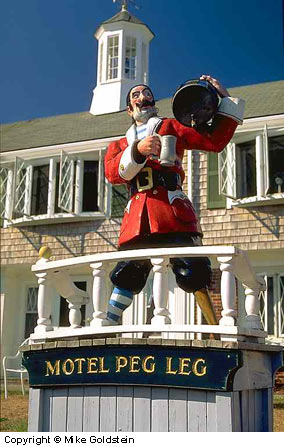
Captain Peg Leg decorates the entrance to the “Peg Leg Motel”, in downtown Rockport. Located just off the beach, with rooms that overlook the harbor, its location allows you to abandon your car for days, and explore Rockport. The low viewpoint (worm’s eye view) allows the Captain to ‘break’ several false horizons, for a strong composition.
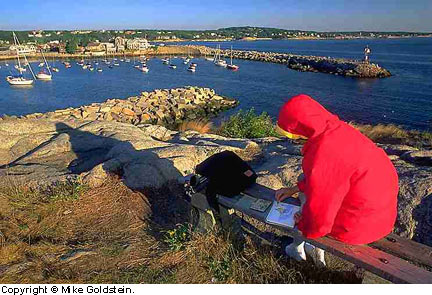
An early-rising artist sketches Rockport Harbor, in the morning sunshine. The Massachusetts coast is a paradise for painters and photographers, with miles of attractive coastline, and many pretty towns. Some flash fill was used here, to “pop” the artist’s red jacket, and fill the shadows in front of her.
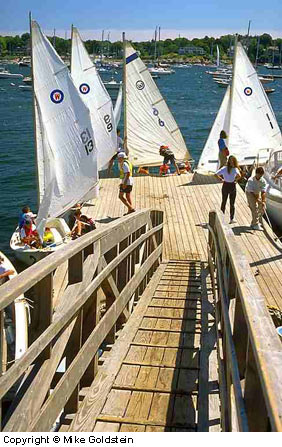
Youngsters prepare to take the dinghies of Marblehead’s sailing school out for a day of tacking and gybing, learning the seagoing skills of this traditional Atlantic town. The rails of the dock’s ramp make great leading lines for this composition, literally pulling your eyes further into the image. Breaking the horizon line with the sailboats produces a stronger photograph.
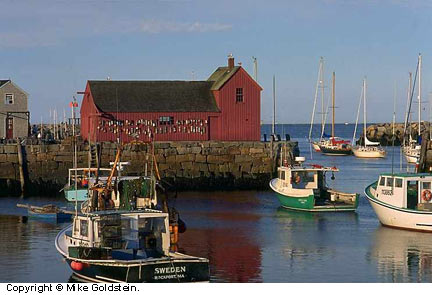
Motif #1 (don’t ask who named it!) is a “destination specific” view that any artist or photographer that has worked the Massachusetts coast must recognize. This building is located right on the end of the Tuna Wharf in Rockport, and offers a variety of compositional opportunities.
As the lovely pink glow of evening light fades, we drive farther along the shore road to the Ocean Edge Inn and Restaurant. Their baked sole, in a cheese and breading sauce, is exquisite, lacking only the forbidden company of a dry white wine to be a perfect meal. Newburyport, a short distance south of Salisbury, was once considered a candidate for the state capital. The largest coastal town north of Gloucester and formerly a shipbuilding center, it is the birthplace of the U.S. Coast Guard. The whole of its downtown area has been completely restored with brick sidewalks and roadways to match the nineteenth century warehouses and storefronts. On a sunny day, the entire center of town seems to glow in a warm light. This is warming filter country, so come prepared. If you can find an elevated view and keep the sky out of your composition, you’ll find images that remind you of the terra cotta rooftops of Venice. A highly saturated film, like Fuji Velvia, is just the thing to use under these circumstances.
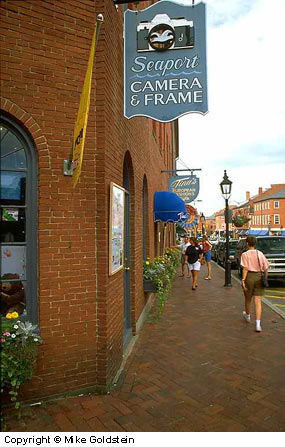
The town of Newburyport has been restored, with its downtown area resplendent in new brick … on the streets, the buildings, everywhere. A warming filter will provide very soft tones, even on cloudy days. Check out the local camera store.
Boat-watchers enjoy the 1100-foot boardwalk that follows the edge of the inner harbor. It’s great for working up an appetite for an Italian dinner at Ciro’s or The Grog, with their marinated lamb tips with pasta. However, the most elegant way to see Newburyport is by open horse-drawn carriage. Todd Woodworth runs daily tours. He picks us up the next day in the late afternoon, right on the town square. Dressed as a coachman, he provides excellent insights into the history and architecture of this attractive place. Promise him a couple of prints (and deliver!), and he’ll stop so you can do some poses and setups, using old buildings as your background.
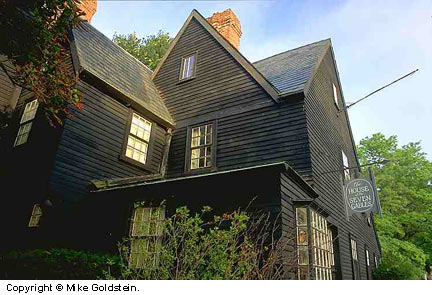
The famous “house of seven gables” in Salem provides an interesting problem in architectural photography. Without a helicopter in your camera bag, it’s hard to find a viewpoint that shows all seven gables! Once you’ve resolved that issue, it’s equally hard to photograph the building, without making it lean to port or starboard!
From Marblehead, we drive south to the main attraction of the South Shore, Plimoth Plantation, a recreated pilgrim village just outside Plymouth, Massachusetts. The year is 1627, and the pilgrims have established a tenuous hold in the New World after a hazardous voyage on the Mayflower. I have the pleasure of watching my wife Allison’s imagination allow her to “time travel” to another period of history, as she reports:
“…From the shadow of his wide-brimmed hat, a farmer smiles shyly at me, continuing his chopping the while, for there are fires to feed, and ovens to warm. He leans on his axe, as I approach, enjoying an excuse to chat.
‘Good day, Mistress,’ he greets me. ‘What brings you to our village?’
‘Good day to you.’ I smile back. ‘I’ve come to learn what courage or madness brought you and your young families to this wild place, so far from England.’
‘Do you value freedom to speak and worship as you please, Mistress? I…ah, but the governor approaches on his rounds, and I must appear busy. God bye ye, Mistress.’”
As in all historical re-creations, there are potential “grab shots” galore to capture the feeling of being in somebody else’s century. The staff, always dressed in the garb of the period, will be happy to pose for you, pausing as they perform their daily chores.
I keep the flash on the camera when I’m shooting like this, with a zoom lens of 90mm or so. I use a monopod as much as I can, since taking the time to set up a tripod will strain everyone’s patience. Grab-shooting will be successful if you practice your technique in advance and don’t become anxious. Bracketing the exposure of every image you make will help you to overcome the careless mistakes often made by a rushed photographer.
Our final stop on this rugged shore is the town of New Bedford, famous as a whaling center in a prior century. The Whaling Museum features huge bones, fascinating ship models, and all the modern technology of a world lit by whale oil lamps. The fence that guards the Museum consists of wrought-iron harpoon heads. The Mariner’s Home, across the street, features a brass plaque on the wall that states not its street address, but its latitude and longitude. It is a fitting place to end our visit.
by Michael and Allison Goldstein
(Editor’s Note: A slide show follows the article with explanatory captions. Click on the link at the end of the article.)

Leave a Reply